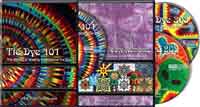Synthetic Dyes for Natural Fibers

by Linda Knutson
Affiliate link

Different types of fiber require different types of dye. Cotton, rayon, linen, tencel, and hemp are all cellulose fibers, and thus use the same classes of dyes: fiber-reactive dyes, vat dyes, azoic or naphthol dyes, and direct dyes. Wool, mohair, and angora are protein fibers, and use completely different dyes, the most important of which for the home dyer is the group called acid dyes. Silk is a special case - it can be dyed with fiber reactive dyes, like cotton, or acid dyes, like wool. Synthetic fibers use entirely different types of dye, depending on the type of synthetic fiber; in many cases, the home dyer will be better off using a high-quality fabric paint, rather than dye, on synthetic fibers.
Advertisements
Dye Cotton, Rayon,
or Silk with
Jacquard Procion MX
Fiber Reactive Dyes

Jacquard Procion Dye
Buy New $3.14—4.17
from Amazon
Neither vat dyes nor naphthol dyes are particularly suitable for the beginning home dyer, as they are more difficult to work with than other dyes. That leaves the fiber reactive dyes, such as Procion MX, Procion H, and Cibacron (a.k.a. Sabracron F) dyes, which are all excellent for home use, and the direct dyes, which are easy to use and more light-fast than most dyes, but which tend toward being dull in color, and have poor washfastness.
Another group of dyes is known as all-purpose, household, or union
dyes. These are actually a combination of acid dyes, which work only
on proteins (and possibly nylon), with direct dyes, according to
Linda Knutson's excellent book, Synthetic Dyes for Natural Fibers. Knutson points out that since half of the dye is thus not
useful for whichever fiber you're using, you are wasting half of what
you're buying, and thus wasting money, if you use these dyes.
Commonly available brands include Rit and Deka (Deka also sells an
extensive line of good fabric paints). The only real advantage to
these dyes is their ubiquity in grocery and drug stores, but their
inadequacies have turned many people, ignorant of the alternatives,
away from the art of dyeing.
There are several different types of dyes that are suitable for use on protein fibers, such as wool, mohair, angora, and also nylon (but no other synthetic fiber). Silk is a special case, different from other protein fibers, and may be dyed either like them, or like the cellulose fibers such as cotton. One striking characteristic of protein dyes is that almost all require some use of heat, which makes them less suitable for direct dye application, such as tie-dyeing. It is possible to use some protein dyes for painting or tie-dyeing if the dyes are then fixed to the fiber by steaming it.
Silk can be dyed with the identical method as cotton, using fiber reactive dyes such as Procion MX, and fixing the dye with soda ash. Although wool will take dye very well with this procedure, the high pH is damaging to wool and other hair-type fibers and should not be used on them. Silk is less easily damaged than wool.
Wool, silk, or nylon can also be acid dyed with Procion MX dye and vinegar. In this protocol, the Procion MX dye actually functions as an acid dye, rather than as a fiber-reactive dye, and steaming the fabric, or otherwise heat-setting it in the presence of moisture, is necessary to optimally fix the dye.
Almost all protein fibers are derived from animals: silk worms in the case of silk, sheep in the case of wool. However, there is one plant-derived fiber which contains only protein, not cellulose, the soy-protein fiber sold under the name of "Soy Silk". It should be dyed like other protein fibers, and not like cellulose fibers. It can take fiber reactive dye at high pH, but it takes the color better when dyed with acid dyes.
Polyester may be successfully colored by using fabric paint, such as pigment "dyes", or truly dyed by the use of disperse dyes. The process of applying disperse dyes inevitably requires high heat. The new "all natural" fiber, Ingeo, which is made from corn, is dyed the same as polyester, as it is chemically quite unlike the true natural fibers made from cellulose or protein.
Also see: About Dyes
 Back to list of FAQs
Back to list of FAQs
Page created: Sunday, August 15, 1999;
Last updated: October 24, 2006;
downloaded: Tuesday, January 06, 2026